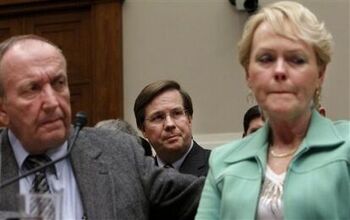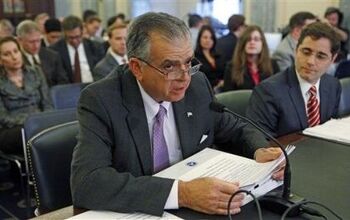The Toyota Testimony, Day One: A Comedy In Three Parts: Act One: The Expert Evidence
It’s been nearly a year since the automotive industry has been treated to a must-watch DC hearing. The last time around, when the executives of America’s automakers went begging to congress for multi-billion dollar bailouts, hearings were heated and combative. Though liberally sprinkled with irony and comedic ignorance, those hearings were, at their heart, a traditional partisan stand-off. But bailouts are also a relatively cut-and-dried topic: you either support them for solid political reasons, or you oppose them for equally solid, equally political reasons. But faced with a national bogeyman of legendary mystery, the lurking terror of unintended acceleration, congress’s task was more complicated than the bailout’s do-we-or-don’t-we dilemma. Tasked with uncovering the truth behind a complex technical problem, is it any wonder that yesterday’s hearings before the House Energy Committee took a turn for the strangely hilarious? [Editor’s note: full prepared statements from all witnesses are available in PDF format here full video of all of yesterday’s testimony is available at CSPAN]
Watching congress tackle the problem of out-of-control cars is something like watching a panel of tenured literature professors struggle to open a jar of pickles: the problem isn’t necessarily that the individuals involved aren’t intelligent, it’s that they are stunningly ill-prepared for the task. Not only are most representatives not trained to understand the complexities of automotive systems, they’re also constitutionally incapable of contemplating the possibility that as one of America’s best-selling brands, Toyota likely sells a lot of cars to stupid people. The possibility that even a small percentage of the unintended acceleration cases might have been caused by (or at least were not averted because of) human error was, at best, only obliquely hinted at for the simple reason that congressional hearings always require a satisfyingly sinister scapegoat. Just as nobody blamed individuals for voluntarily taking on risky mortgages during the subprime lending crisis hearings, there was little doubt that anybody other than Toyota and the NHTSA would be blamed for the deaths resulting from sudden unintended acceleration. Therefore, congress’s task was to understand the problem in such a way that consciously kept attention on these two, admittedly imperfect organizations.
Luckily for congress, there is no shortage of “expert witnesses” willing to place all of the blame on Toyota and the NHTSA, and the first act of yesterday’s hearings opened with testimony from a select few of these witnesses. These witnesses, Sean Kane of Safety Research & Strategies, David Gilbert of Southern Illinois University, and unintended acceleration victim Rhonda Smith of Sevierville, Tenn, were called to fill in the obvious gaps in the committees knowledge of the complexities of sudden unintended acceleration. Unfortunately, these three witnesses probably confused the committee as much as they did enlighten it.
Ms Smith was the first witness to place her statement on the record, and she delivered her testimony with the kind of folksy gravitas that makes congress weak in the knees. Better yet, her story was so outrageously inexplicable that congress was faced with only two options: take her story at face value or suggest (as Toyota has) that Ms Smith’s story can not be fully explained without relying on a belief in divine (or diabolical) intervention. Ms Smith and her husband certainly didn’t deny the role of the supernatural in her experience, but because the hearing’s pre-determined villains had implied that the lack of rational explanations for her incident placed a certain amount of responsibility on her shoulders, repetition of such suggestions would not have served the hearing’s purpose.
In providing an inexplicable example of unintended acceleration, the Smith’s testimony set the tone for the rest of the hearing. No other witnesses were called to provide supporting evidence of the apparent simultaneous brake, engine and transmission control failure that Ms Smith claims to have experienced. As a result, the hearings proceeded with congress’s limited engineering knowledge enhanced only by a single scenario in which an untrained witness described a vehicle that was clearly possessed by some mysterious, malignant force. Which, as it turns out, suited the final two expert witnesses just fine.
Sean Kane, an analyst for the independent Safety Research & Strategies, was not able to offer any better explanation for Toyota’s unintended acceleration problems than the Smiths. First blaming Toyota for failing to recognize the problem of pedal entrapment, Kane then went on to claim that pedal entrapment couldn’t explain most UA complaints on the record. This strategy added to Toyota’s halo of shame while consciously failing to present any rational explanation for what might be causing the incidents beyond the lurking, sci-fi menace of electronics gone mysteriously wrong. Kane’s expert backup, Dr. Gilbert, was no more helpful, proving only that he was able to cause UA in Toyotas without triggering an error code.
After one first-hand account and two expert witnesses, the committee actually knew less than they had before the hearing began. Worse still, the evidence they did hear was orchestrated in such a way as to leverage this ignorance: the Smiths proved only that no driver should be held accountable for UA in a Toyota because shifting into neutral and even reverse at 100 mph (let alone using brakes and emergency brakes) hadn’t stopped the car (until it did), while Kane proved that mysterious Toyota-exclusive electronic problems are widespread, and Gilbert proved that they are untraceable.
Needless to say, this was no coincidence. As these three witnesses fielded confused questions from the committee some key facts arose about their testimony: first, Kane’s report was sponsored by five law firms, each of which have suits pending against Toyota and second, that Kane had paid Gilbert for his analysis. If these facts (and Kane and Gilbert’s huffy reactions to them) altered the opinion of any committee members, it didn’t matter. These were the only witnesses called, and when they were finished, the time had come for congress to grill the bad guys: Toyota’s Jim Lentz and and Secretary of Transportation Ray LaHood.
More by Edward Niedermeyer
Latest Car Reviews
Read moreLatest Product Reviews
Read moreRecent Comments
- El scotto Under NAFTA II or the USMCA basically the US and Canada do all the designing, planning, and high tech work and high skilled work. Mexico does all the medium-skilled work.Your favorite vehicle that has an Assembled in Mexico label may actually cross the border several times. High tech stuff is installed in the US, medium tech stuff gets done in Mexico, then the vehicle goes back across the border for more high tech stuff the back to Mexico for some nuts n bolts stuff.All of the vehicle manufacturers pass parts and vehicles between factories and countries. It's thought out, it's planned, it's coordinated and they all do it.Northern Mexico consists of a few big towns controlled by a few families. Those families already have deals with Texan and American companies that can truck their products back and forth over the border. The Chinese are the last to show up at the party. They're getting the worst land, the worst factories, and the worst employees. All the good stuff and people have been taken care of in the above paragraph.Lastly, the Chinese will have to make their parts in Mexico or the US or Canada. If not, they have to pay tariffs. High tariffs. It's all for one and one for all under the USMCA.Now evil El Scotto is thinking of the fusion of Chinese and Mexican cuisine and some darn good beer.
- FreedMike I care SO deeply!
- ClayT Listing is still up.Price has been updated too.1983 VW Rabbit pickup for sale Updated ad For Sale Message Seller [url=https://www.vwvortex.com/members/633147/] [/url] jellowsubmarine 0.00 star(s) (0.0) 0 reviews [h2]$19,000 USD Check price[/h2][list][*] [url=https://www.ebay.com/sch/i.html?_nkw=1983 VW Rabbit pickup for sale Updated ad] eBay [/url][/*][/list] Ceres, California Apr 4, 2024 (Edited Apr 7, 2024)
- KOKing Unless you're an employee (or even if you are) does anyone care where physically any company is headquartered? Until I saw this story pop up, I'd forgotten that GM used to be in the 'Cadillac Building' until whenever it was they moved into RenCen (and that RenCen wasn't even built for GM). It's not like GM moved to Bermuda or something for a tax shelter (and I dunno maybe they ARE incorporated there legally?)
- Fred It just makes me question GM's management. Do they save rent money? What about the cost of the move? Don't forget they have to change addresses on their forms. New phone numbers? Lost hours?

































Comments
Join the conversation
My opinion, she is a lier. She sold the car after it tried to kill her. Obviously without warning the new buyers. The car has had 27,000 trouble free miles put on it since. Either she is lying or she is a heartless wench who sold a life threatening car to someone else. She looks nice to me, so I am going with lier.
Good joke calling Safety Research & Strategies "independent." You should know better, as it's difficult to conceive of an outfit more completely in the pockets of the trial lobby that SR&S. Here's a WSJ article that lays out the sordid story: http://tinyurl.com/y9bqawx .